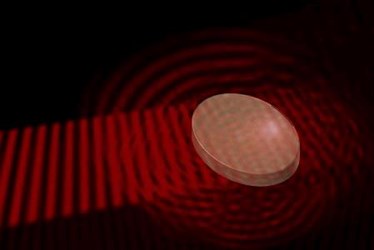TU Wien Researchers Develop Cloaking Technology
By Jof Enriquez,
Follow me on Twitter @jofenriq

Researchers at TU Wien (Vienna) have developed a type of cloaking technology that renders opaque materials invisible by letting the flow of light pass through the medium unperturbed.
When light and matter interact, certain light waves are reflected, while some are transmitted by a scattering medium. If backscattering is strong enough, it can stop the propagation of light and cause large intensity fluctuations. Scientists are interested in controlling the scattering of waves for purposes of detection, imaging, and transmission through disordered materials.
"Complex materials such as a sugar cube are opaque, because light waves inside them are scattered multiple times," says Professor Stefan Rotter, Institute for Theoretical Physics, TU Wien. "A light wave can enter and exit the object, but will never pass through the medium on a straight line. Instead, it is scattered into all possible directions."
Other research groups have sought to overcome this challenge by guiding light waves around an object, by using spatial light modulators, or by fabricating objects that emit light themselves.
However, TU Wien researchers, along with colleagues from Greece and the United States, propose a different approach to unimpeded light propagation to achieve the effect of hiding an object in a "cloak of invisibility," or "induced transparency".
Supported by computer simulations, the researchers demonstrate that "adding a judiciously chosen distribution of gain and loss to a disordered medium will make waves lose all of their internal intensity variations such that they propagate through the disorder without any back-reflection," according to the study paper published in Light: Science and Applications.
Specifically, an opaque material with random irregularities is irradiated from above with a spatially modulated pump beam that generates a unique wave pattern.
"The crucial point is to pump energy into the material in a spatially tailored way such that light is amplified in exactly the right places, while allowing for absorption at other parts of the material," says Professor Konstantinos Makris from the University of Crete (previously TU Wien). “To achieve this, a beam with exactly the right pattern has to be projected onto the material from above – like from a standard video projector, except with much higher resolution."
If the specific wave pattern matches the irregularities of the material responsible for scattering, then that allows another beam of light traveling from the left of the medium to propagate freely throughout the material.
"Mathematically, it is not immediately obvious that it is at all possible to find such a pattern," says Rotter. "Every object we want to make transparent has to be irradiated with its own specific pattern – depending on the microscopic details of the scattering process inside. The method we developed now allows us to calculate the right pattern for any arbitrary scattering medium."
The research team is planning to conduct actual experiments using sound waves, initially, as they are considered easier to handle than light waves.
Beyond these experiments, however, many issues surrounding the technology need to be explored further.
"The extension to two- or three-dimensional scattering systems, if possible, could add angular selectivity to spectral filtering. The time domain has not yet been addressed: what would happen to a pulse propagating in such a medium as it becomes transparent? What about the robustness of the solution in the presence of nonlinearities or modal competition? There is still a lot to learn and investigate," wrote Patrick Sebbah, Department of Physics, the Jack and Pearl Resnick Institute for Advanced Technology, Bar-Ilan University, in a discussion in Nature Photonics.
